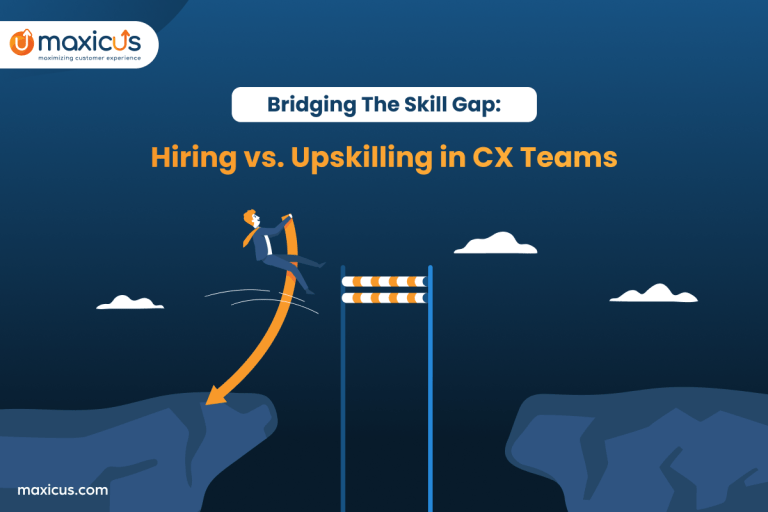The future of eCommerce customer service: Recipes to create a great eCommerce CX
The starting point of success for any business comes with exceptional customer service. In the eCommerce industry, it’s important to build a long-term relationship with customers as it leads to retention and profit maximization. In the retail industry, many companies tend to lose touch with good client service and hence, potential customers. Managing customer support in eCommerce requires the utmost professionalism and efficiency. E-commerce customer service provides a strategy and framework for providing an excellent shopping experience in your online store. That strategy should encompass where and how you deliver that support, expectations for speed of response time, and how customer support agents can rectify customer issues.
Customer service is the role dedicated to helping customers get the value they paid for from a product or service, especially when things go wrong.
A study by Gartner reveals that 89% of businesses are expected to compete mainly on customer experience.
This means the future of businesses will mostly rely on offering remarkable service to customers. Since the inception of E-commerce, different tools have been used to cater to the needs of customers. The advent of more efficient and technical systems has somewhat replaced the traditional methods of support in E-commerce.
Why customer experience matters for eCommerce?
PwC’s survey found that a third of customers worldwide will abandon a beloved brand after just one bad experience. But, 65% of respondents in the US said a positive experience is more persuasive than the best of advertising.
Great experiences impact brand loyalty and customer retention, as well as encourage positive online reviews and word-of-mouth marketing. A negative customer experience produces the opposite results. So perhaps it’s time to consider reinvesting your advertising budget.
eCommerce customer service in Post COVID era
It’s no news that the COVID-19 disruption has created a fast-changing and less-predictable environment for most industries, leaving many leaders and businesses floating adrift. And as consumers have entered a survival mode, it’s all about staying safe and connected, and most profoundly, being digitally connected at all times.
How can e-commerce capitalize on the current trend and thrive by moving far beyond the basic sites and apps?
Entrepreneurs and business leaders are looking at this situation as an opportunity to transform into a new “business as usual,” and they should consider these immediate actions as they fight to win on what they’ve built.
Can eCommerce win the customer acquisition and retention battle? This crisis shifts consumer priorities and behaviors, and these will most likely stick as new habits after the pandemic is over. Agile businesses respond with convenience, product assortment, and transparency, ensuring they engage with their customers wherever they are to build business growth, reinforce customer loyalty, and penetrate new categories and territories. In the same way that COVID-19 will leave lasting emotional scars, it will also create lasting emotional bonds for long after the pandemic has passed.
Friction is the enemy of e-commerce– and indeed of the consumer as well. The rise of digital eCommerce customer service is creating new customer touchpoints, enabling shoppers to interact with businesses through a complex network of categories and platforms.
But how can eCommerce customer service combat the risk of disjointed or confusing customer journeys?
For agents, tackling the challenge of customers can be daunting. Hyper-personalized omnichannel eCommerce customer service model is a key focus on aiding the customer in the discovery, purchase, and post-purchase experience, while they are delivering exceptional site functionality, descriptive product pages, and superior customer service to outperform the competition.
Want to increase sales and customer loyalty?
How digital transformation & technology is driving eCommerce customer service?
What exactly creates a good customer experience? Despite the rising demands of increasingly connected consumers, only a few of those surveyed pointed to technology as central to a business’s ability to meet their expectations.
In this era of instant gratification, most people only make the connection between technology and customer experience when the former “fails, is slow, or disrupts the process.”
Although Gartner predicts that chatbots will be integrated across 25 percent of all customer service and support operations by 2020, it would be foolish for any business to take humans out of their support plans any time soon.
For eCommerce customer service teams, you’re no longer restricted to waiting for the phone to ring or fax to come through. Digital-first is not just about being reactive. It’s about being proactive in the way you help your customers, who use a wide range of channels to seek out support. Social media, reviews sites, forums, and communities are all now part of the customer service ecosystem.
While chatbots can help companies cut response times and provide an around-the-clock presence, a Chatbots.org survey of 3,000 consumers revealed that repeating information and context to a live agent after explaining the situation to a chatbot was a major frustration for 59% of people.
Indeed, making technology more human is the key to enhancing the customer experience. Although improvements in AI are coming through, these bots still need human back up.
What would be the right customer service channels?
In a brick-and-mortar shop, customer support can be delivered — ideally — face-to-face. But eCommerce customer support channels are often asynchronous via email, delivered via live chat, or by phone calls. In addition to other challenges unique to eCommerce with more busy customers, you’ll need to monitor multiple channels and offer lightning-fast response times.
To best serve your customers, you need an integrated omnichannel approach, but exactly what that means for your business may differ from others. You need to know your customers, where they are, and where they prefer to engage.
Once you establish the best channels for your business, make sure you’re offering a consistent, proactive support experience across those channels.
Social media
Show customers, you care. Meet your customers where they are. For many retailers, answering customer inquiries via social channels can provide a quick and easy way for customers to engage with you to provide feedback and address concerns.
Social media monitoring is important too, some customers will discuss your business and your service on social channels instead of engaging with you. Being aware of those customer interactions can help you adjust your processes, if necessary, and respond proactively.
Email support
Email templates are a great place to start if you’re trying to speed up your customer service game, but make sure you don’t sacrifice too much of that personal touch. Customers still want to know they’re communicating with an authentic human that truly wants to help solve their problems. Don’t be afraid to treat it as an actual conversation between a real customer and a real support agent.
Live chat
Customers have high expectations for quick support. Live chat can help you respond in real time — and it enables your team to handle multiple issues at once, rather than sitting on hold for the next available representative.
Customer satisfaction rates with live chat usage are holding steady at a relatively high rate, reaching about 83.04% globally in 2019.
Chatbots are also used to streamline customer support as they are enabled to provide information around the most common questions.
Call center support
Offer a direct line to your business. Many younger shoppers may prefer online messaging, but offering phone support is still important. If you have someone available to answer telephone calls from customers, be sure to include your phone number clearly on your website — in as many places as possible.
Omnichannel customer support
Lastly, the evolution of the internet and emerging E-commerce stores have made it to the point that having an omnichannel is critical. Being available 24/7 to end-users is crucial as this is not only what customers want, but also ‘demand’. Hence, if a company is hoping to deliver an excellent client service but is present on just one medium then it’s time to rethink the business’ support strategy!
Every business wants a loyal customer base. The focus should be on efficient customer support and is available on every channel where contact can be made. Therefore, omnichannel support in eCommerce is a leading factor towards higher customer satisfaction levels.
The power of personalization
Customers don’t necessarily want a product or experience personalized to them. Instead, they want to feel heard, valued, and appreciated. But the way to do this is often through personalization.
That’s where an outsourcing partner can improve your eCommerce customer service game. Whether you sell on your online store or multiple marketplaces around the world, an omnichannel approach pulls order details and any previous messages from all your sales channels into one place so you can stay personal when communicating with your customers at scale.
Despite high-profile data breaches, consumers are increasingly willing to share info with companies—as long as there’s something in it for them.
Everybody’s different! Customers are increasingly willing to share data that enables personalization and a great customer experience. Providing you use it responsibly!
A 2017 study conducted by YouGov discovered that 43 percent of the 1,145 consumers surveyed agreed they would exchange personal data to save money through personalized promotions, discounts, or deals.
Meanwhile, 39 percent would do so for speedier problem-solving. Bottom of the barrel: irrelevant retargeting, which 32 percent dubbed “an invasion of privacy.”
Personalization isn’t about letting people know that you’re creating an experience just for them. It’s about making things easier for customers. And this is in line with what customers expect.
How to monitor the success of your eCommerce customer service
There are many eCommerce metrics out there for online merchants to keep track of. Monitoring some key goals related to the customer experience is essential for driving customer-focused company culture. Monitoring these metrics will help you understand the true experiences of your customers.
C-SAT rates
To see how you’re doing on this front, you need to ask customers how satisfied they are with your company’s products or services, alongside a rating scale of one to five to ascertain your C-SAT scores:
- Very Unsatisfied
- Unsatisfied
- Neutral
- Satisfied
- Very satisfied
To calculate your percentage score, divide the number of satisfied customers (4 and 5) by the total number of responses, and multiply by 100. The higher your score, the better.
NPS
Net Promoter Score, or NPS, is the percentage of your customers who say they’d recommend your store to someone else. It’s useful for figuring out how strong your customer experiences are and how they may be driving conversions.
To get your NPS, you need to survey customers with the question: How likely are you to recommend this brand or product to a friend, colleague, or family member?
Calculating this figure is a little more complicated than figuring out your customer satisfaction rate, but it is pivotal.
Customer Effort Score
This metric is all about how much effort customers have made to interact with your brand – a key signal of how smooth-running your eCommerce customer experience is.
You can ask customers how easy it was to interact with your brand, on a scale from one to seven.
- Extremely easy
- Very easy
- Fairly easy
- Neither
- Fairly difficult
- Very difficult
- Extremely difficult
If you’re maximizing your Net Promoter Score, Customer Effort Score, and Customer Satisfaction Rate, you’ll be well on the way to perfecting your eCommerce customer experience!
To calculate your CES score, divide the sum of all your scores by the number of responses you received. Your score will be somewhere between one and seven – the lower it is, the better.
Customer experience is hugely influential in terms of repeat business and word-of-mouth marketing. So, in essence, it’s hugely important to the future growth of your online business.
Companies that excel in providing great customer experiences have an extremely powerful eCommerce marketing tool in their hands. In many ways, this can influence consumers more than the most extravagant advertising campaigns. For this reason, you should use every resource at your disposal to build a great eCommerce customer experience – from technology and personalization to re-targeting and thoughtful site design.
Guide to e-commerce customer service outsourcing
In-house or outsourcing: Which one to go for?
One of the first tasks that businesses outsource is customer service. The most cited reasons for starting with customer service are:
- Customer service doesn’t take days off, the inquiries a seller receives are constant.
- Customer service tickets are urgent and time-sensitive.
- Customer service is difficult to manage, tickets come from multiple sources.
- Customer service is easier to scale, the process for ticket resolution is repetitive.
Customer service is a specialized service and it quite tough. It requires highly experienced and qualified professionals to manage the whole process efficiently. By outsourcing, you will be gaining access to professionals who have years of expertise and experience in customer service. They understand the needs of customers and will be able to assist you in retaining them. Also, you do not have to invest in training them!
Since your business is online, it means that there is no closing or opening time. Your shop is open at all times. So, suppose a customer is purchasing a product or service in the middle of the night or during the wee hours of the morning and he/she faces a problem. Who will he/she turn to? Unless you are a call center/e-commerce company, you will not be open 24/7 and you might lose out on potential customers.
But, if you outsource customer service to a third party, it will be their responsibility to cater to every need of your customers whether day or night. They will be functioning 24 hours a day and 7 days a week. You never have to worry about losing a customer.
Outsource e-commerce customer service to guarantee enriching conversations with customers. Since that is their sole function, they can handle every aspect of it quite efficiently. But, when you have too many things to worry about, you automatically become a little careless while solving your customers’ queries or issues. Now, when running a business, you would never want your customers to feel that they are not important to you. This is where outsourcing plays a really important role and can be the difference between gaining customers and losing out on them.










